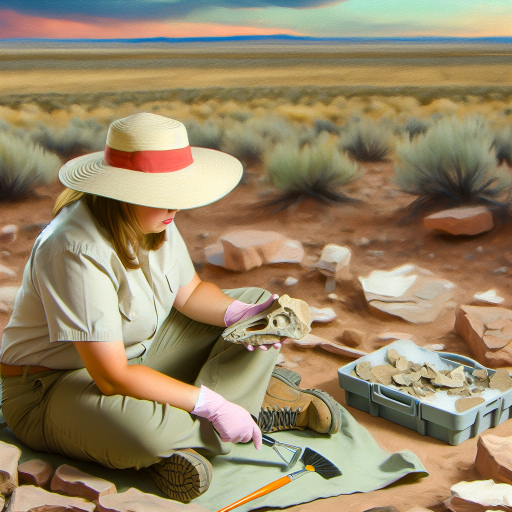Introduction
Botanist conduct essential fieldwork and laboratory work, advancing knowledge and discoveries in the field of botany.
Fieldwork involves conducting research in natural habitats, while laboratory work involves studying plant samples in controlled environments.
Importance of Fieldwork and Laboratory Work
Both types of work are crucial for botanists to gain a comprehensive understanding of plant species and ecosystems.
Fieldwork allows botanists to observe plants in their natural environments and study their interactions with other organisms.
On the other hand, laboratory work enables botanists to conduct controlled experiments and analyze plant samples in detail.
Comparison between Fieldwork and Laboratory Work
Fieldwork offers botanists the opportunity to study plants in real-world settings, providing valuable insight into their behavior and adaptations.
It allows researchers to collect data on plant diversity, distribution, and ecological relationships.
However, fieldwork can be challenging due to unpredictable weather conditions, limited access to resources, and the need for extensive travel.
On the other hand, laboratory work provides a controlled environment for botanists to conduct experiments and analyze plant samples with precision.
It allows researchers to study plant physiology, biochemistry, and genetics in detail.
Laboratory work also offers the advantage of replicating experiments and controlling variables, which is essential for scientific accuracy.
In essence, both fieldwork and laboratory work are essential for the advancement of botany.
While fieldwork offers a unique opportunity to study plants in their natural habitats, laboratory work enables detailed analysis and experimentation.
By combining both approaches, botanists can gain a comprehensive understanding of plant biology and contribute to scientific knowledge.
Let’s explore how botanist contribute through fieldwork and laboratory work to advance the field of botany.
Benefits of Fieldwork
Opportunity to Observe Plants in Their Natural Habitat
Fieldwork offers botanists the opportunity to observe plants in their natural habitat.
This firsthand observation allows botanists to understand plant behavior, growth patterns, and ecological relationships.
Seeing plants in their environment provides insights that are critical for understanding how they adapt to various conditions.
Ability to Collect Diverse Plant Samples
Another significant benefit of fieldwork is the ability to collect diverse plant samples.
Botanists working in the field can gather a variety of specimens from different regions and ecosystems.
This diversity enhances research by offering a broader range of data for analysis.
Collecting plants directly from nature ensures that scientists study living organisms in their truest form, which might not be possible with cultivated specimens in a lab.
Chance to Interact with Other Scientists and Experts in the Field
Fieldwork also presents the chance to interact with other scientists and experts in the field.
Collaboration is essential in the world of botany, and fieldwork fosters this exchange of knowledge.
While working on-site, botanists often join forces with ecologists, geologists, and conservationists, expanding their understanding of the broader ecosystem.
These collaborations lead to shared discoveries, innovative solutions, and a more holistic approach to studying plant life.
Additionally, fieldwork offers botanists the unique chance to discover new species.
Many plant species remain undocumented, especially in remote areas, and fieldwork is the key to finding them.
Identifying these new species expands botanical knowledge and highlights the importance of preserving diverse ecosystems.
Fieldwork also provides an in-depth look at how plants respond to environmental changes.
Botanists can observe real-time reactions to factors like temperature fluctuations, soil conditions, or water availability.
This understanding is crucial in addressing pressing global challenges such as climate change, habitat loss, and biodiversity decline.
By studying plants in their natural surroundings, scientists can better predict how ecosystems will adapt to future changes.
Moreover, fieldwork brings a sense of adventure and discovery to the profession.
It takes botanists beyond the confines of a lab and into the wild, where they can witness the beauty and complexity of nature.
This hands-on experience enriches their passion for botany, keeping their work engaging and meaningful.
Basically, fieldwork offers botanists a unique blend of scientific exploration, collaboration, and discovery.
By observing plants in their natural habitats, collecting diverse samples, and interacting with fellow experts, botanists deepen their understanding of plant life.
This approach enhances research, promotes conservation, and ensures that the science of botany remains dynamic and impactful.
Read: Essential Skills and Tools for Modern Chemists in America
Challenges of Fieldwork
Weather Constraints and Unpredictable Conditions
Fieldwork presents unique challenges for botanists, starting with weather constraints and unpredictable conditions.
Fieldwork requires botanists to work outdoors, making them vulnerable to unexpected changes in weather.
Sudden storms, extreme heat, or heavy rainfall can disrupt data collection or destroy delicate plant samples.
Unpredictable weather can limit the time botanists spend in the field, reducing the accuracy of their observations.
Conditions can also vary dramatically from one day to the next, making it difficult to replicate studies or maintain consistency.
Difficulty in Accessing Remote Locations
Another challenge in fieldwork is the difficulty in accessing remote locations.
Botanists often study plants in isolated areas, far from cities or easily accessible regions.
Reaching these locations may involve navigating rugged terrain, dense forests, or steep mountainsides.
In some cases, these areas can only be reached by hiking long distances, using off-road vehicles, or flying in by helicopter.
This creates logistical challenges, such as carrying all necessary equipment, ensuring safety, and managing limited time in the field.
The physical demands of accessing remote locations also increase the risk of injury or exhaustion, further complicating research efforts.
Limited Control Over Variables Compared to Laboratory Work
Additionally, fieldwork offers limited control over environmental variables compared to laboratory work.
In the field, botanists must contend with constantly changing conditions, such as soil composition, temperature fluctuations, or interactions with other plants and animals.
These factors make it difficult to isolate specific variables or determine clear cause-and-effect relationships.
Unlike a controlled laboratory environment, where conditions can be carefully manipulated, field studies often require botanists to adapt to the natural ecosystem’s unpredictability.
This lack of control can complicate data collection and analysis, making it harder to draw definitive conclusions.
Despite these challenges, fieldwork remains an essential part of botanical research.
Observing plants in their natural habitats provides critical insights that cannot be replicated in the lab.
However, it requires botanists to be adaptable, resourceful, and patient when faced with the uncertainties of working outdoors.
Whether dealing with unexpected weather, remote locations, or uncontrolled variables, fieldwork offers a rewarding yet challenging experience for botanists.
It brings them closer to the plants they study and deepens their understanding of the natural world.
Ultimately, the unpredictability of fieldwork contrasts sharply with the control and stability of laboratory work.
While laboratory research provides precision and control, fieldwork delivers firsthand experience with plants in their natural environments.
Each approach has its advantages and drawbacks, and together, they form a comprehensive foundation for botanical research.
Botanists who thrive in the field accept the unpredictability as part of the journey toward scientific discovery.
Read: The Role of Chemists in US Environmental and Sustainability Efforts

Benefits of Laboratory Work
Controlled Environment for Precise Experiments
Laboratory work offers botanists a controlled environment for conducting precise experiments.
In the lab, researchers can manipulate variables, ensuring consistency in their studies.
This controlled setting allows for greater accuracy in testing hypotheses and observing specific outcomes.
Unlike fieldwork, where environmental factors are unpredictable, laboratory conditions can be maintained to suit the needs of each experiment.
Ability to Conduct Detailed Analysis on Collected Samples
One of the key advantages of laboratory work is the ability to conduct detailed analysis on collected samples.
In the lab, botanists can examine plant specimens using advanced equipment like microscopes and chemical analyzers.
This access to sophisticated tools enables them to investigate intricate details such as cellular structures, genetic makeup, and chemical compositions.
These insights help botanists draw more accurate conclusions about plant biology and behavior.
Moreover, the lab setting provides the time and focus needed to study these details without the time pressures faced during fieldwork.
Opportunity for Collaboration with Other Researchers
Collaboration is another significant benefit of working in a lab.
Unlike fieldwork, which often requires working in remote areas, laboratory research brings scientists together in one space.
This proximity fosters collaboration and knowledge sharing among researchers from different specialties.
Working with others in the lab allows botanists to exchange ideas, troubleshoot challenges, and develop new methodologies.
Such collaboration can lead to innovative breakthroughs in plant science, as each researcher brings a unique perspective to the table.
Additionally, laboratory work often speeds up the research process.
In the field, experiments can be delayed due to changing weather, difficult terrain, or seasonal plant cycles.
In the lab, botanists can replicate the necessary conditions to run their experiments as often as needed.
This ability to repeat tests under consistent conditions enhances the reliability of results.
It also allows researchers to gather data more efficiently, accelerating the pace of discovery.
In a lab, botanists can safely store their samples and research materials.
This secure environment ensures that delicate or rare specimens remain preserved for extended study.
Fieldwork, in contrast, can sometimes result in damaged or lost samples due to unpredictable outdoor elements.
Laboratories also offer controlled storage options like refrigeration or low-humidity chambers, further protecting specimens.
Finally, laboratory work allows botanists to work year-round, regardless of season or weather.
Field research can be limited by environmental conditions, but labs provide a space where experiments can continue without interruption.
This year-round consistency is crucial for long-term projects and helps botanists maintain momentum in their research.
Ultimately, laboratory work offers a stable, collaborative, and precise environment for conducting in-depth botanical research that complements the unpredictability of fieldwork.
Read: Day in the Life: An Environmental Scientist‘s Typical Day
Explore Further: Forensic Anthropology: Studying Human Remains
Transform Your Career Today
Unlock a personalized career strategy that drives real results. Get tailored advice and a roadmap designed just for you.
Start NowChallenges of Laboratory Work
Laboratory work presents unique challenges for botanists that differ greatly from the unpredictability of fieldwork.
Lack of Real-World Context Compared to Fieldwork
One major drawback is the lack of real-world context.
Plants in a lab setting grow under controlled conditions, but these do not fully reflect nature.
In a natural environment, plants respond to complex, ever-changing factors like weather, soil composition, and animal interactions.
This missing context can limit the relevance of lab findings when applied to real ecosystems.
As a result, botanists may struggle to draw accurate conclusions about how plants behave in the wild.
Potential for Contamination or Errors in Experiments
Another significant challenge of laboratory work is the risk of contamination or errors during experiments.
Even in highly regulated environments, accidental contamination can occur.
Foreign substances from the air, tools, or other specimens can interfere with the integrity of an experiment.
These contaminations can skew results, leading to inaccurate data and possibly weeks of wasted effort.
While lab protocols are designed to minimize these risks, they cannot eliminate them entirely.
For a botanist, even a small error can mean starting the experiment all over again.
Limitations in Studying Plant Behaviors Outside of the Lab Environment
Laboratory work restricts the study of certain plant behaviors.
Some behaviors, such as plant interactions with insects, pollination patterns, or responses to specific weather conditions, are difficult to recreate in a lab setting.
Controlled environments allow botanists to isolate specific variables, but they often miss out on the dynamic, interconnected factors that influence plant life outdoors.
For example, while a lab can simulate light and moisture, it cannot replicate the unpredictable patterns of rain or wind.
This limitation makes it difficult to observe how plants react to fluctuating conditions in their natural habitats.
Another constraint is space.
Laboratories typically provide limited room for plants to grow.
Some plants, especially large species or those with extensive root systems, need space to develop naturally.
In a lab, these spatial restrictions can hinder the study of full plant growth cycles or root behaviors.
This constraint may prevent botanists from fully understanding how plants adapt to their environments.
Overall, laboratory work offers valuable insights, but its challenges require careful consideration to ensure meaningful results.
Read: The Impact of Technology on the Chemist Profession in the US
Comparison of Data Collection
Differences in Data Quality and Quantity Between Fieldwork and Laboratory Work
In botanical research, data collection methods vary between botanist fieldwork laboratory work, each offering unique advantages.
Fieldwork allows botanists to collect real-world data from natural environments, where plants interact with diverse ecosystems.
This hands-on approach provides high-quality, raw data on plant behaviors, adaptations, and interactions with their surroundings.
Fieldwork, however, often limits the quantity of data collected due to environmental challenges and logistical constraints like weather or accessibility.
In contrast, laboratory work offers controlled conditions that allow for more precise measurements and higher quantities of data.
Experiments in the lab enable researchers to isolate specific variables, making it easier to study plant responses to particular conditions such as light, water, or soil nutrients.
Laboratory work can generate extensive datasets but may miss the complexity of real-world conditions.
Plants may behave differently in an artificial environment than they do in their natural habitats, which could lead to skewed conclusions if only lab data is considered.
Importance of Combining Both Types of Work for Comprehensive Research
Both botanist fieldwork laboratory work have limitations in data quality and quantity.
Fieldwork excels in ecological accuracy but may suffer from lower data precision and smaller sample sizes.
On the other hand, laboratory work provides abundant, controlled data but may fail to capture the full complexity of natural ecosystems.
For example, plants in a lab might not experience real-world stressors like herbivory, competition, or fluctuating weather patterns, leading to an incomplete understanding of their growth and survival.
To conduct comprehensive botanical research, combining both fieldwork and laboratory work is essential.
When integrated, these approaches offer a more holistic view of plant biology, capturing both ecological interactions and precise physiological responses.
Field data grounds the research in reality, while laboratory experiments allow for in-depth exploration of specific plant traits under controlled conditions.
Together, they provide a complete picture, enhancing the accuracy and relevance of botanical studies.
Examples of Studies that Integrate Fieldwork and Laboratory Work for Botanical Research
A great example of this integration can be found in studies of climate change’s impact on plant species.
Fieldwork captures how plants respond to changing temperatures, droughts, or altered growing seasons in their natural habitats.
Meanwhile, laboratory experiments simulate future climate conditions, allowing scientists to predict how plants might adapt or struggle in the future.
Another example is the study of invasive species.
Fieldwork tracks how invasive plants spread in real ecosystems, while lab experiments test the effects of different control methods.
In essence, botanical research benefits most when it combines both fieldwork and laboratory work.
Each method complements the other, filling in the gaps left by relying solely on one approach.
Together, they offer a more thorough understanding of plant biology and ecosystem dynamics, making for robust, reliable scientific discoveries.
Find Out More: Nanotechnologist vs. Other Science Professions
Conclusion
Botanist Fieldwork Laboratory Work are both essential components of botanical research.
Fieldwork allows botanists to observe plant life in its natural habitat, while laboratory work provides controlled conditions for detailed analysis.
Emphasizing the complementary nature of these two approaches is crucial for a comprehensive understanding of plant biology.
By combining fieldwork and laboratory work, botanists can gain a holistic perspective on plant species and ecosystems.
For botanists, it is important to strike a balance between fieldwork and laboratory work to ensure well-rounded research outcomes.
Both types of work offer unique insights that can inform each other and lead to more robust scientific discoveries.
Additionally, botanists are encouraged to explore new techniques and technologies in both botanist fieldwork laboratory work.
Innovations in data collection, analysis, and experimentation can enhance the quality and efficiency of botanical research, ultimately advancing our knowledge of plant life on Earth.
By continuously refining their approach and embracing new tools, botanists can contribute to the greater understanding and conservation of plant species worldwide.
It is through the integration of botanist fieldwork laboratory work, along with a spirit of curiosity and innovation, that botanists can make meaningful and lasting contributions to the field of botany.
[E-Books for Sale]
The Big Book of 500 High-Paying Jobs in America: Unlock Your Earning Potential
$19.99 • 500 High-Paying Jobs • 330 pages
Explore 500 high-paying jobs in America and learn how to boost your career, earn more, and achieve success!
See All 500 High-Paying Jobs of this E-Book
1001 Professions Without a Degree: High-Paying American Jobs You Can Start Now
$19.99 • 1001 Professions Without a Degree • 174 pages
Discover 1001 high-paying jobs without a degree! Unlock career tips, skills, and success strategies for just $19.99!




